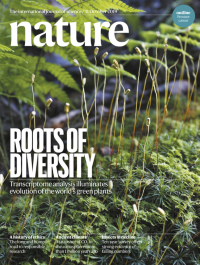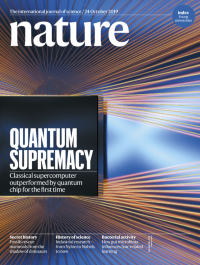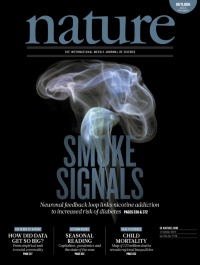Volume 574
-
No. 7780 31 October 2019
Roots of diversityThe cover shows an example of the ‘entangled bank’ of interacting species that Darwin described in the conclusion of On the Origin of Species. Shown are ferns (Dryopteris intermedia) and mosses (Polytrichum commune and Thuidium delicatum), just three of nearly half-a-million species that make up the remarkable diversity of green plants. In this week’s issue, James Leebens-Mack, Gane Ka-Shu Wong and colleagues from the One Thousand Plant Transcriptomes initiative report the vegetative transcriptomes of 1,124 species that span plant diversity, including green plants, glaucophytes and red algae. The authors construct a phylogenomic framework, which they use to infer the evolutionary relationships between species and to plot the timing of genomic changes and diversification events during the history of green plants. They find that large expansions of gene families preceded the origins of land plants and vascular plants, whereas whole-genome duplications seem to have occurred repeatedly throughout the evolution of flowering plants and ferns.
Focal Point
-
No. 7779 24 October 2019
Quantum supremacyIn this week’s issue, John Martinis and his colleagues describe a significant step in the development of quantum computing. For the first time, the researchers have demonstrated experimentally that a programmable quantum computer can outperform the world’s most powerful conventional processors — a state known as quantum supremacy. The team used a quantum processor made up of 53 functional qubits to tackle a task that involved sampling the output of a quantum circuit generating random numbers, a task that becomes increasingly demanding the more qubits there are in the system. The quantum processor, dubbed Sycamore, was able to collect 1 million samples from the circuit in roughly 200 seconds, a feat that the authors estimate would take a state-of-the-art supercomputer around 10,000 years to perform. The cover shows an artistic rendering of the Sycamore chip.
Nature Index
-
No. 7778 17 October 2019
Smoke signalsCigarette smoking dramatically increases the risk of type 2 diabetes, but the mechanisms underlying this effect have remained elusive. In a paper in this issue, Paul Kenny and his colleagues reveal that, in rats, the transcription factor TCF7L2 mediates a signalling circuit that connects neurons in the brain activated by nicotine to blood-glucose regulation by the pancreas. The researchers show that when nicotine activates nicotine acetylcholine receptor (nAChR) proteins expressed on neurons in the medial habenula region of the brain, it also leads to adverse responses to nicotine that limit intake as well as to the release of glucagon and insulin by the pancreas. This in turn raises the levels of blood sugar, which is associated with a higher risk of developing diabetes. In addition, the raised levels of blood sugar create a feedback loop by inhibiting nAChRs expressed by medial habenula neurons, blocking adverse responses to smoking and so helping to establish nicotine dependence. TCF7L2 modulates the entire signalling circuit, thereby linking nicotine addiction with an increased risk of diabetes.
Spotlight
-
No. 7777 10 October 2019
Stars collidingThe cover image shows a stage in a modelled sequence of two massive stars merging. The simulation, presented in this week’s issue by Fabian Schneider and his colleagues, looks at how magnetic fields are generated during the merger process. Around 10% of massive stars (those of more than 1.5 solar masses) have a strong surface magnetic field, and it has been suggested that this may be the result of stellar mergers. The researchers used a 3D magnetohydrodynamic simulation to test this hypothesis. In the cover image, a primary, more massive star has just been disrupted as it merges with a secondary star (lighter colours represent stronger magnetic fields). The large black spiral shows the location of gas mainly stemming from the primary star, where no magnetic field is yet present. The black parts in the centre trace the core of the secondary star, where there is also no magnetic field yet (as the merger progresses the magnetic field permeates the whole body). The simulation reveals that such mergers do indeed produce stars with strong fields. The researchers suggest that the merger product leaves behind a magnetar — a highly magnetic neutron star — when it finally explodes as a supernova at the end of its life.
-
No. 7776 3 October 2019
Parental guidanceThe cover shows a strawberry poison frog (Oophaga pumilio), a species found in Central America that displays a range of different skin colours. In this week’s issue, Yusan Yang and her colleagues reveal how maternal influence shapes both mating preferences and male competition among these frogs — and how this can potentially drive the formation of new species. In imprinting, offspring learn traits from their parents that later in life help to shape their behaviours. The researchers found that among the frogs, female offspring preferred to mate with male frogs that were the same colour as their mother. Similarly, males are more aggressive towards males that are the same colour as their mother. The overall result, the teams suggests, is that this is likely to reduce gene flow between frogs that bear divergent mating traits, thereby setting the stage for speciation to occur by sexual selection.





